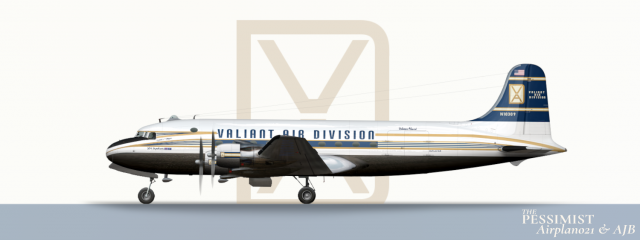
1945 Douglas DC-4
- Owner: ThePessimist (View all images and albums)
- Uploaded: May 02 2022 12:40 AM
- Views: 1,368
- Album Valiant Airways

The shadow of conflict crept across America as the Allied situation in Europe looked increasingly dire. With the declaration of war, the American economy finally began to follow the trajectory that President Roosevelt had tried so hard for so long to encourage. Valiant Holding Group's collection of civilian construction contracts dried up but increasing demand for military equipment provided a new avenue for growth. In 1941, Winston Westbrook, in what would be his last major move with VHG, authorized a partnership with several arms manufactures to ship raw and completed materials by sea and air. At this point, Westbrook's health had begun to decline and given the seeming about face on the issue of air transport some historians suspect that he didn't really make this discussion even though it went through his office.
1942 brought a day that will live in infamy and a change to VHG's operating environment. The surface ships division worked overtime to keep up the flow of raw materials like iron ore and coal into America's beating industrial heart. Liberty ships were constructed at Valiant's shipyard in River Rouge and then repositioned by Valiant crews to the Washington Navy Yard where they were officially commissioned with United States Navy and fitted with ordinance. Valiant's DC-3s were not enough to handle existing routes and shuttle employees on the return trip from DC to Detroit. This lead Valiant to successfully acquire some civilian spec DC-4s from their business partners at Douglas. These new DC-4s rapidly became the mainstay of what crews affectionately nicknamed the Federal Passage. The service proved popular with other companies in the Detroit region that needed to reach the Federal Government to negotiate wartime contracts. At its, peak the service operated a flight in each direction every two hours.
Westbrook was touring a munitions factory in London with a group of other important American business leaders in 1943 when a freak accident led to a major explosion which killed him along with a number of other businessmen. VHG's new director would be Herbert Rogers who had been made famous by his spend big to win big corporate strategy in the transportation sector in the Northeast. Rogers came to the board with a vision for the post-war future. The Air Transport Command had proven that regular service could be maintained over the Atlantic. Rogers thought that Valiant’s air services could replace the great ocean-liners as the preferred method of crossing the big blue expanse of the Atlantic. Valiant became increasingly involved in the Atlantic front of the war and logistical operations stateside as preparations for D-Day were made. Whilst VHG had in some ways struggled to serve regular civilian leisure customers with scheduled passenger services, government contracts were altogether more regular and logical, much like the shipping contracts with which the company was most comfortable.
With Hitler on the backfoot and the war in Europe looking increasingly close to completion, Rogers turned corporate focus back to civilian matters. Rogers’ first order was to restructure parts of the corporation to allow for more focused divisional management. This led to a new brand identity and logo for what was now officially branded as the Valiant Air Division (VAD). The carrier’s DC-4s were repainted in a spiffy new scheme featuring the new logo and later the DC-3s would also receive similar treatment. The regional network out of Grand Rapids was significantly cut back to divert more planes to a new hub at Washington DC’s then brand-new National airport. The airbridge to London remained elusive until, after much planning, a route originating at National and terminating a London Hurn was officially inaugurated on Christmas Eve 1945, just months after V-J Day. This made VAD, which had been a relatively small operator before the war, one of the first American carriers to conquer the pond without the aid of a so-called flying boat. Whilst newer DC-6s would swiftly the replace the DC-4s on Transatlantic service before even a year had passed, maintenance issues with the newer type meant that Valiant DC-4s were a regular sight at Hurn until at least 1948, at which point they remained a mainstay of the Federal Passage and VAD’s other trunk routes.

 Sign In
Sign In Create Account
Create Account














